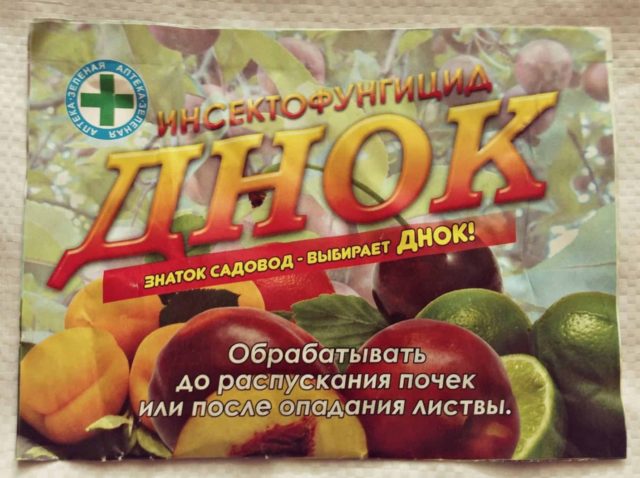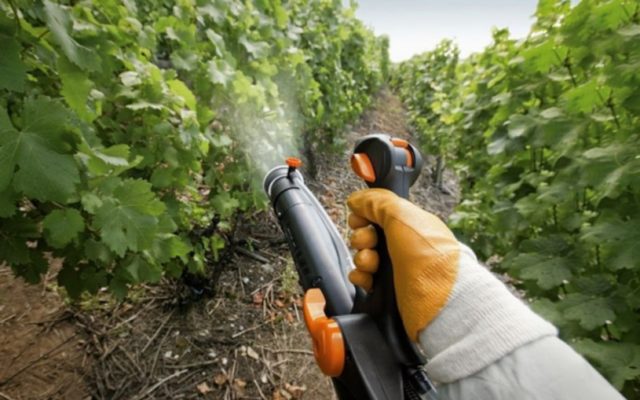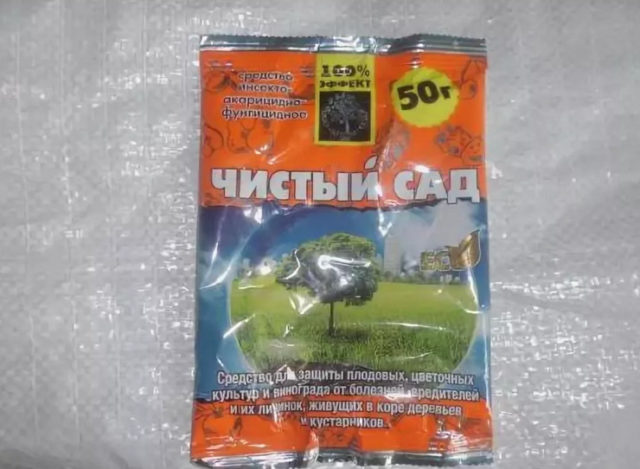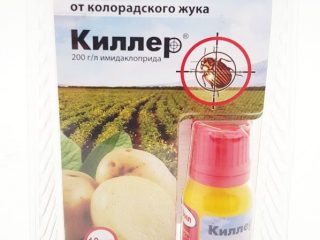Content
Every gardener understands that it is impossible to grow a good harvest without treating pests and diseases. Now the range of chemicals is very diverse, but only some of them have a wide spectrum of action and combine acaricidal, insecticidal and fungicidal properties at the same time. One of these universal products is the spraying drug Dnok. But in order to use it correctly, you must first study the instructions.

The lasting effect of using “Dnok” lasts for 1 month
Description of the drug
Fungicide "Dnok" has a second class of toxicity. This means that if used incorrectly, it can harm plants and human health.
Compound
The fungicide is produced in the form of a yellow powder with a strong unpleasant odor. The main active ingredient is dinitroorthocresol, which is present in 40% concentration. Additional ingredients include sodium and ammonium sulfate. Thanks to this, the effectiveness of “Dnok” increases, and the active component is evenly distributed in the product.
Operating principle
When spraying plants, the fungicide “Dnok” inhibits the development of fungal spores and prevents their reproduction. And since the product also has acaricidal-insecticidal properties, it also destroys larvae and adults of wintering pest species. The maximum concentration of the active substance in plant tissues is recorded 48 hours after treating the garden with “Dnok”. You can clearly see the positive result 4 days after spraying the foliage.
What diseases and pests are they used for?
According to reviews from experienced gardeners, the “Dnok” preparation for spraying the garden simplifies plant care, since one treatment replaces several.
The preparation should be sprayed on wintering pest species:
- scale insect;
- leaf roller;
- aphid;
- mites;
- slowpoke;
- mole;
- moth;
- false scale insect;
- worm.
Due to its versatility, Dnok can be used against most fungal diseases that persist on trees, berry bushes and grapes in winter.
The use of the drug is justified when:
- spotting;
- curliness;
- moniliosis;
- scab;
- coccomycosis;
- oidium;
- anthracnose;
- necrosis;
- cercosporiosis;
- rust;
- powdery mildew;
- gray rot;
- mildy.

Blooming buds, ovaries, young shoots and buds are sensitive to the action of "Dnok"
Consumption rates
The amount of working preparation “Dnoka” varies depending on the crop being treated. Therefore, to achieve maximum effectiveness, you should strictly follow the instructions. Exceeding the dosage may have negative consequences for plants.
Recommended consumption of Dnoka working solution:
- 10l/100 sq. m. – stone fruit trees;
- 15l/100 sq. m. – pome crops, berry bushes;
- 8 l/10 sq. m. - grapes.
Application area
The spraying preparation "Dnok", according to the instructions for use, is intended for spring and autumn treatment of gardens and vineyards on an industrial scale. The fungicide destroys pathogens that overwinter on plants.
Can it be used by gardeners and gardeners?
Due to the high toxicity of Dnok, it is not recommended to use it privately. But, according to experts, the fungicide can be used to treat trees and shrubs if the plantings are located at a distance of 1 km from residential premises. In addition, it is important to take all precautions.
Instructions for use of the drug Dnok
In accordance with the instructions, “Dnok” (double blow) must be used during certain periods of the year. And also when preparing the fungicide solution, strictly adhere to the dosage.
When is the best time to treat with Dnok?
Spraying with “Dnokom” should be done in early spring and late autumn. In the first case, it is necessary to carry out treatment until the buds appear. Therefore, when the temperature reaches above zero, not lower than +4 degrees, a fungicide should be used. It is important to have time to carry out the treatment before the sap begins to flow, since it is at this time that the product shows maximum effectiveness.
In the second case, the fungicide should be used after leaf fall and after all work with the soil under bushes or trees is completed, but the air temperature should not be higher than +5 degrees.
Application of "Dnoka" in the fall involves spraying the branches, trunk and top layer of soil with fallen leaves. For this treatment, it is recommended to use a 0.5-1% fungicide solution. At low air temperatures, the active component of “Dnoka” penetrates the soil to a depth of 7 cm and thus destroys pathogens and pests that overwinter not only on the plant, but also in the top layer of soil.
Preparation of the solution
To prepare the Dnoka working solution, you must initially pour 500 ml of warm water into a separate container, and then add 50-100 g of the drug powder to it, stir thoroughly. Then increase the volume of liquid to 10 liters.

The drug is poorly soluble in cold water
Rules for using Dnok
Depending on the type of crop, the fungicide needs to be used differently.If used in spring, the concentration of the active component should not exceed 4%, which is achieved by dissolving 400 g of powder in 10 liters of water. And during autumn treatment with “Dnokom” - no more than 1% based on 100 g of product per bucket of water.
Treatment of fruit trees with Dnok
The drug "Dnok" is recommended for use on stone fruit trees (apricot, plum, cherry, peach) and pome crops (apple, pear, quince).
Treatment should be done against the following pests:
- scale insect;
- types of ticks;
- slowpoke;
- leaf roller;
- mole;
- aphid;
- psyllid;
- moth.
Also, timely spraying of trees with “Dnok” helps to destroy pathogens of curl, spotting, clasterosporiasis, coccomycosis, moniliosis and scab. The consumption rate of the fungicide working solution is 10-15 liters per 100 square meters. m of plantings.
How to use Dnok for grapes
Before processing this crop, pruning should be done first. You must begin the procedure immediately after completing the preparatory stage.
Treating grapes with “Bottom” helps prevent the spread of mites, scale insects and aphids. As a fungicide, this drug is effective against:
- anthracnose;
- oidium;
- spotting;
- cercospora;
- necrosis.
The consumption of the Dnoka working solution in this case should not exceed 8 liters per 100 sq. m. m.

It is necessary to spray before the sap begins to flow in the plants.
Spraying berry bushes with Dnok
This drug is also recommended for processing gooseberries and currants. According to the instructions, it helps to get rid of:
- aphids;
- scale insects;
- leaf rollers;
- moth;
- false scale insects;
- ticks.
The use of this fungicide against diseases such as powdery mildew, septoria, rust, spot and anthracnose is also justified.The flow rate of working fluid when spraying shrubs should be within 15 liters per 100 sq. m. m.
Advantages and disadvantages
"Dnok", like other drugs, has pros and cons. Therefore, before making a choice, you need to familiarize yourself with them in advance.
Advantages of "Dnok":
- Versatility of use.
- Wide spectrum of action.
- Economical consumption.
- Long-lasting protective effect.
- Affordable price.
The disadvantages of the fungicide include toxicity class 2, which requires increased safety measures. In addition, you cannot spray young seedlings with “Dnok”, as this leads to a slowdown in their growth and the appearance of burns on the bark.
Precautionary measures
Judging by the reviews, “Dnok” (double blow) is one of the most effective drugs that have a detrimental effect on most common garden pests and fungal pathogens. But it must be used with caution.
Work with the fungicide should be carried out in special clothing and a protective mask on the face, since severe irritation occurs when the solution comes into contact with areas of the skin and mucous membrane. The fungicide can be used no closer than 2 km from water bodies.
After spraying, you need to take a shower, wash your work clothes, and wash the spray bottle with a soda solution. If you accidentally swallow the working preparation “Dnoka”, you should not drink alcohol, hot drinks, fats, or make compresses.
Storage rules
The fungicide can be stored only if the integrity of the packaging is maintained. The shelf life of the powder is 3 years from the date of production. The product should be stored in a dark, dry place out of reach of children.
Dnoka powder is explosive, so do not place the product near containers with flammable liquids.
How long can diluted Dnok be stored?
The shelf life of the prepared Dnoka solution does not exceed 2 hours. Therefore, the product must be used immediately after preparation. In this case, it is necessary to clearly calculate the required amount of the drug for processing, since it is impractical to prepare it for future use.
Analogues
In the absence of "Dnok", you can use other chemicals that have a similar effect. Each of them must be used in accordance with the attached instructions.
Analogues of "Dnok":
- Clean Garden Nitro.
- Brunka.
- Nitrafen.
- Clean Garden.
Conclusion
The spraying preparation Dnok is highly effective when used correctly. But the high level of toxicity does not allow its widespread use. Therefore, experts recommend using “Dnok” only in special cases when gentle drugs have not brought positive results. And we should not forget that this remedy can be used no more than once every 3 years.












